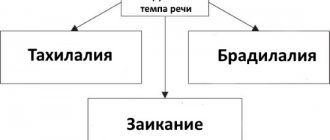Symptoms of tachylalia
Manifests itself in both speech and non-speech symptoms.
1. Abnormally fast rate of speech, but phonetics and syntax are not sharply distorted.
2. Uncontrollable rapidity of speech.
3. Disorders of speech attention, repetitions, hesitations, rearrangements of syllables, unclear pronunciation of phrases.
4. Inner speech disorders.
5. Impaired written speech.
6. Violations of general motor skills (accelerated pace of all movements, hyperactivity, tics are common)
7. Neuroticism, motor restlessness even in sleep, short temper, slight excitability.
8. Unstable attention, switching very quickly from object to object. All types of memory suffer. Speech cannot keep up with racing thoughts.
Tachylalia is very often combined with other speech problems.
Causes
According to statistical data from psychologists and neurologists, tachylalia is more often diagnosed in nervous, easily excited children suffering from hyperactivity.
The causes of violations include the following:
- Heredity
- Inner speech rate disorders
- Braking rate delay
- Copying the speech of others
- Incorrect education of a child’s speech in the family. The reluctance of adults to listen to the baby's long, slow tirade forces him to rush through articulation.
- Mental disorders.
Symptoms of polternism and battarism.
With battarism and polternism, there are also both speech and non-speech symptoms.
1. Impaired oral speech (haste, disturbances in the formation of individual sounds, rearrangements, omissions, changes in sounds and syllables, loss of words and phrases). Speech consists of short, unrelated sentences.
2. Stumbling in speech. The sound is not pronounced immediately. The lips and tongue may move silently, resembling convulsive movements.
3. Breathing and diction problems.
4. Voice disorders (no sonority, monotony, symptoms of voice overstrain)
5. Reading disorders (when reading, long phrases are divided into short ones, the main idea of what is being read is lost).
6. Violations of writing (stopping the hand in the process, omissions, substitutions, rearrangements of syllables and letters, words and entire phrases).
7. General motor skills are impaired (swiftness, quick turns, scattered movements, grimaces).
8. Instability of attention (they don’t know how to listen to others, they don’t catch thoughts well and don’t remember them)
9. Scattered thinking, lack of logic.
10. Uncritical (they often do not notice their defect, adults rarely seek help themselves).
Prevention of occurrence
Parents can protect their child from the effects of external negative factors - prevent injuries, monitor his development and take an active part in this process. Their task is to protect the baby from stressful situations, fright, fear, and extraneous noise. The environment should be calm, and the parents' demands on the child should be reasonable. But you shouldn’t indulge him in everything; avoid excessive pampering. A healthy and strong nervous system will not only prevent the development of tachylalia, but will also have a positive effect on the general condition of the body.
Also consider the fact that children imitate their parents in many ways, especially at that age. The culture of your speech and tempo, articulation should be an example for him. Make sure that he does not speak while inhaling and does not repeat sounds or syllables.
The differential difference between tics during stuttering and chaotic movements during tachylalia is that in the first case they occur during conversation. And in the second they are not related to speech.
Corrective work for tachylalia.
Corrective action is carried out comprehensively.
Medical effects include calming, restorative, and effects depending on the severity of anxiety, irritability, and hyperactivity.
Psychotherapy is aimed at re-education of the individual and socialization.
Physical therapy is recommended. When performing exercises, inhibitory reactions, endurance, concentration, and attention are trained. All exercises are performed with a count or to melodic music at a slow pace, smoothly, calmly.
Speech therapy work is in many ways similar to the correction of stuttering, but the speech therapist takes into account the mechanisms and symptoms of this particular disorder. Logorhythmics must be included in speech therapy correction. The basis of such classes is a slow pace.
In the work to overcome polterterns and battarism, the formation of concepts and their grammatically correct expression are very important. Working to overcome speech tempo disturbances is often a preventative measure for stuttering.
Etiology of dysfunction
Human speech develops in accordance with conditioned reflexes. Its indicators are determined by the state of the brain, which provides connections with the articulatory apparatus. Nerve impulses transmit a signal about the need to move the speech organs. Thus, in order for its characteristics to coincide with the norm, the child must have normal functions of the central nervous system, organs of the speech apparatus and the absence of hearing pathologies. The task of speech therapy and psychology is to assess speech indicators and work on its deviations.
One of the conditions for its development is the child’s communication with adults and peers. According to etiology, speech disorders are divided into functional (neurogenic logoneuroses and social type), organic (in the presence of somatic pathologies). Dysfunctions can be a consequence of trauma during childbirth, long-term infectious diseases suffered at an early age. External factors include an unfavorable family environment associated with a lack or excess of parental attention.
According to one version, tachylalia manifests itself in children whose parents speak quickly, that is, the role of a genetic factor is noted. According to V. A. Kurshev, fast speech speed is associated with the pace of thinking, and the violation refers to mental and speech deviations. D. Weiss (1950) spoke about the connection between pathology and stuttering. M.E. Khvattsev (1959) believed that the reason for the congenital speech motor insufficiency of the apparatus lies in the lack of an example on the part of adults. V. M. Bekhterev (1926) argued that its cause lies in the predominance of excitation processes. M. Nadolechny characterized persons with battarism as hasty and restless people with weak memory and attention disorders.
To correct speech underdevelopment, methods of psychological stimulation, vasoactive therapy, and speech therapy are used. Tachylalia can be pure and functional, accompanied by stuttering. Its clinical picture is often accompanied by violations of vocabulary, grammar, and phonetics. Its separate subspecies are battarism and paraphrase.
Etiological factors include somatic diseases, psychogenic environment and habit. According to the results of neurological studies, even in the prenatal period, the fetus undergoes corresponding physiological and anatomical changes in the brain.
Prognosis of tachylalia.
It largely depends on the structure of the defect (the disorder is expressed in a pure form or is a manifestation of a more complex syndrome). Human mental development and behavior are of great importance.
Overcoming tachylalia also depends on those around you, on the cooperation of relatives with a doctor and speech therapist, on the timeliness and complexity of the impact.
In this article, I touched on the topic of correcting various types of accelerated speech rates. Tachylalia and its varieties are complex and not fully understood speech disorders.
If you have questions about this topic, write in the comments, I will definitely answer. If you found this information useful, please share it with your friends.
Diagnostics
In order to recognize a speech pathology in a child, you must first contact not a speech therapist, but a neurologist or psychiatrist. Diagnosis of the disease occurs on the basis of analysis of external manifestations and laboratory research methods.
Most often, the doctor advises the preschooler to undergo the following procedures:
- EEG: to identify signs of epilepsy, disorders in the functioning of brain structures.
- Echogram (ultrasound): will determine the presence or absence of tumors and neoplasms.
- MRI: will reveal organic brain lesions.
A mandatory condition for diagnosing a speech disorder is an interview with a psychiatrist. The specialist determines the level of development of the preschooler, finds internal family and everyday reasons for the development of pathology. Excludes or confirms the presence of mental disorders.
A psychologist helps determine the level of motor, sensory, volitional, and cognitive development.
Speech function is examined by a speech therapist. The state of speech motor skills, the acoustic apparatus, the ability to place stress, pauses, and the pace of speech and writing are subjected to a thorough analysis.
A psychologist, psychiatrist, and speech therapist use diagnostic tests and specialized tasks when examining a child.
The diagnosis of tachylalia is made after a complete examination of the preschooler, collection of anamnesis and analysis of diagnostic results from all specialists.
Poltern is in speech therapy
Yu. A. Florenskaya believed that the mechanisms of paraphrasia and aphasia are the same. The main disorder in aphasia and paraphasia is associated with difficulty in voluntarily finding words and is expressed as: violation of the correct flow of syntactic sequences of speech, looseness of sentences, involuntary insertion of additional elements into speech, violation of the letter composition of a word, the presence of literal paraphrases.
Poltern (stumbling)
- pathologically accelerated speech with the presence of intermittent speech tempo of a non-convulsive nature (stammering, stumbling, unreasonable pauses). Characterized by a violation of general and speech motor skills. Often combined with other speech disorders.
Starting from the works of Aristotle, it is considered in a group of various disorders of organic and functional origin. Since the end of the 19th century. it is identified as an independent speech disorder. Experimental studies are aimed at distinguishing stumbling primarily from stuttering. A. Kussmaul (1879) identified dyslogical speech disorders, or dysphrasia, caused by a violation of the content side of speech, and spasmodic laloneuroses, to which he classified stuttering as a purely articulatory speech disorder. He was the first to point out the possibility of confusing stumbling with stuttering and proposed a way to distinguish between these disorders: attracting attention to speech in stutterers increases convulsiveness, in people with stumbling it improves speech; People who stutter at home speak better, and people who stumble speak worse.
An analysis of the signs of half-turn and stuttering shows that in the first case, people usually do not realize their shortcoming, while people who stutter suffer from it. With concentrated attention, speech with half turns and paraphrases improves, and with stuttering, it worsens. In the presence of certain people or in a responsible environment, children with paraphrase and polternes speak better, while those who stutter speak worse. During casual conversation, the symptoms of polternes and paraphrasia intensify, while the symptoms of stuttering decrease.
In the 30-50s of this century, electroencephalographic studies were conducted confirming the differences between stuttering and stumbling.
How to normalize the state of speech
Treatment of tachylalia involves an integrated approach.
The correction therapy scheme includes:
- prescription of medications (nootropics, sedatives);
- physiotherapeutic effects (galvanic collar, electrosleep);
- physical therapy;
- rhythmic exercises (normalization of motor skills);
- speech therapy classes (development of logic, attention, development of rhythm and slowing down the rate of speech).
The course of treatment is 9-10 months. Drug therapy is prescribed according to the presence or absence of concomitant diseases. Often tachylalia is mixed and accompanied by dysarthria. It can also be combined with neurological pathologies.
The effectiveness of physical therapy lies in training inhibitory reactions, endurance, attention and concentration. During exercises, play melodious and calm music.
To increase efficiency, training is carried out in small groups. This disciplines children and reduces psychomotor excitability. At first, it is not easy for them to adapt to new conditions; the speech therapist sets the pace by clapping their hands and tapping on an object. Children learn to speak while hitting the ball and jumping. Such gaming techniques ease the load on the nervous system. Musical rhythm is developed by voicing the text to the accompaniment. At the beginning of the course, preschoolers are taught a slow pace of speech; after mastering it, they are transferred to a normal rhythm.
To practice the sequence of thinking, teachers work with children according to a drawn up plan. Compiling a retelling promotes the development of thinking. They also practice saying the beginning of a phrase, and the children finish it.
Note! Tachylalia is a persistent speech deformation, so it is necessary to monitor the child for a year after the end of therapy. This will prevent you from speeding up again and will help you maintain your acquired skills.
The purpose of speech therapy exercises is to control the speed and synchrony of actions. To do this, the patient must perform a set of exercises designed to train breathing, voice strength, practice rhythm, attention, and coordination of movements. The course is designed for 2-3 months, after a break it can be resumed.
If tachylalia occurs against the background of neurological and mental diseases, the prognosis of the dynamics of the patient’s condition is difficult to predict. In any case, a lot depends on the parents and relatives; they need to provide psychological support to the patient.
Stages of speech therapy work:
- silence mode (maximum limitation of contacts with others);
- reading at a slow pace;
- editing what is said;
- compiling a collective story;
- preparation for public speaking.
If 2-3 months are not enough to eliminate the problem, take a break and continue therapy. Subsequently, over the course of a year, students will strengthen their correct speech skills independently at home. The health prognosis for tachylalia depends on its structure: is it presented in its pure form or is it a secondary manifestation of a more complex disease. In this case, the dynamics of the patient’s condition depends on his mental development and behavior in society. It must be treated without fail; it will not go away on its own.
Definition
Cluttering is a special form of speech defect, which is accompanied by slurred articulation, pauses and rapid speech rates, confusion of statements or unintentional distortion of word forms. Refers to violations of the tempo and rhythmic aspects of articulation.
ICD-10 code: F98.6 excited speech
Translated from English, “clattering” means “cluttering or clogging.” It is extremely difficult to understand what a person with such a syndrome is saying. The patient's speech is confused, uneven in rhythm, and choking.
Cluttering syndrome is often confused with stuttering. It is very important to understand that logoneuroses are associated with muscle tension and spasms of the muscles of the articulatory apparatus, but clattering is not. When a child stutters, secondary symptoms of a speech defect appear: rapid and frequent blinking, flaring of the nostrils, and general muscle tension. These external signs of articulation disorders during cluttering are not observed if it is not complicated by logoneurosis.
On a note! Abroad, cluttering was first described in 1717; the first scientific work on the disease was published in 1964 (by Professor Deso Weiss). In Russia this diagnosis has not yet been officially made.
Advantages of tachylalia correction in our clinics
Experienced staff
Treatment of tachylalia in children and adults is carried out by experienced specialists, speech therapists, psychologists, aphasiologists and neurorehabilitation specialists with more than 15 years of experience. Specialists use effective methods, including proprietary programs for the correction of tachylalia, and develop exercises to develop interpersonal communication skills and develop imaginative thinking.
Interesting form of training
Classes for children with tachylalia are held in a playful way. This activates children's cognitive activity and develops their logical thinking. Classes with a children's speech therapist help in the future to communicate without problems with their peers and quickly adapt to new groups.
Treatment
To correct speech disorders during clattering, it is necessary to create a work plan with a speech therapist. Therapy should be aimed at solving problems with tempo, rhythm of speech, and developing mental functions. During the treatment process, the child learns to formulate and express thoughts logically, consistently, and build semantic structures. At the same time, patients are engaged in the development of phonemic hearing, train the articulatory apparatus, and eliminate defects in sound pronunciation.
The speech therapist is recommended to organize the course of classes as follows:
- Speech tasks are pronounced at a slow pace. You can use reflected (following the teacher) or conjugate (simultaneous) repetition. Phrases and words are spoken slowly and clearly. It is recommended to set the desired speech rhythm at the beginning of the lesson and stick to it exactly; you can use soft music.
- Work is being done on emotionality and expressiveness of speech. Speech therapists ask the child to pronounce one phrase with different emotions, in a whisper, loudly, etc.
- Practice your ability to express your thoughts correctly. It is recommended to memorize poems, compose stories based on pictures, conduct dialogues, and retell what you read or heard.
- Training the skill of planning a statement. First, the child pronounces a phrase, a few sentences to himself, then out loud.
- Include articulation and breathing exercises in the lesson to form legible, intelligible speech. This technique is also useful for polternes (stumbling). For classes with schoolchildren, choose breathing exercises according to Strelnikova.
- To consolidate the purity of pronunciation of sounds, arrange them and correct them if necessary.
- Work with schoolchildren on dyslexia, dysgraphia, and penmanship.









